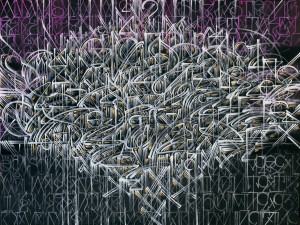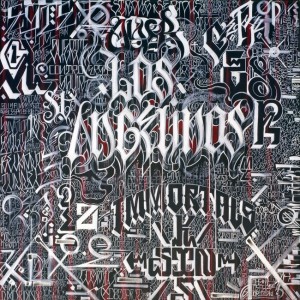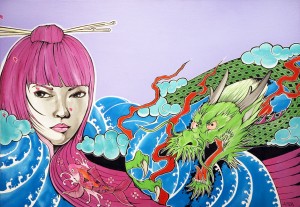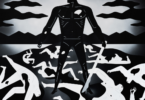- Anthony Green, Brick + Mortar Show Review - December 2, 2013
- Artist Spotlight: Andrew King - November 21, 2013
- Artist Spotlight: Gregory Siff - November 14, 2013
Name: Alex “DEFER” Kizu
City/State: Los Angeles, CA
Website: www.defer1.com
Contact: defer@defer1.com
Alex “DEFER” Kizu appreciates the past, but he embraces the future. He is a traditionalist and an innovator. He’s a graffiti writer and a fine artist who rides the line between old school and new. His work is aggressive and in your face, but it’s beautiful—as graffiti should be—and hey, it’s L.A.—love it or hate it…
 Los Angeles is embodied in DEFER’s work. It is gritty and urban, but it’s beautiful. It looks old and battle hardened, but it’s modern and futuristic. It has deep-rooted history and culture. It wants to challenge you. It wants you to put in some work to like it. It tells a complex story of struggle and success that nowhere or nobody else can tell. Oh yeah, and it’s all tagged up with graffiti.
Los Angeles is embodied in DEFER’s work. It is gritty and urban, but it’s beautiful. It looks old and battle hardened, but it’s modern and futuristic. It has deep-rooted history and culture. It wants to challenge you. It wants you to put in some work to like it. It tells a complex story of struggle and success that nowhere or nobody else can tell. Oh yeah, and it’s all tagged up with graffiti.
Graffiti is all about attitude. It’s about getting your name up more than the other writers; it’s about telling the other guy that your skills are better than his—tell him you and your work are going to live on longer. It’s about put or shut up. DEFER has lived, survived and risen up in this mad, confrontational scene; hell, he is one of the architects who built the foundation.
DEFER has been around writing all over L.A. since before it was accepted and fashionable. He’s been doing it since the 80’s. Dude’s got street cred, but he doesn’t hang his hat on his laurels. He came up in this competitive, combative world, but he doesn’t seem to get caught up in the cockiness and arrogance of the street scene. He speaks softly but carries a big spray can.
Kizu is the Zen master of graffiti. He’s not caught up worrying about swagger; there’s no pretense. Humility is abundant. His work speaks for itself and he knows it. He wants to be quiet and make art; furthermore, he wants other people to want to make art. It’s his passion and his compulsion. He gets so caught up in it that if you see DEFER in person, chances are you will only see his back because he is face planted against a wall spraying it, painting a canvas or hunched over, scribbling with a marker on whatever he can get a hold of.
At first glance, it’s easy to think of a DEFER piece as containing only one style; in actuality, his pieces contain many different styles. Complex and complete art works don’t have just one layer of paint; they contain countless layers of information. DEFER’s pieces certainly do this. Usually artists achieve this with stacking layers of paint on top of layers of paint. DEFER goes beyond and achieves this in a unique manner.
 Paint layering, writing dissimilar hand styles on top of each other and applying varying degrees of difficulty and design are a few artistic ways he works. He easily proves himself as a writer and a painter; furthermore, he becomes an historian and a storyteller in his work. Many of his pieces contain the names of his predecessors, his cohorts and his crewmembers. By tagging these names along with words—immortal, controversy, survive, salvation—DEFER is honoring the story of L.A. graffiti by documenting scenes, characters and plots from its past and present.
Paint layering, writing dissimilar hand styles on top of each other and applying varying degrees of difficulty and design are a few artistic ways he works. He easily proves himself as a writer and a painter; furthermore, he becomes an historian and a storyteller in his work. Many of his pieces contain the names of his predecessors, his cohorts and his crewmembers. By tagging these names along with words—immortal, controversy, survive, salvation—DEFER is honoring the story of L.A. graffiti by documenting scenes, characters and plots from its past and present.
Another key feature of DEFER’s typographic work is an insanely complex bundle of intertwined, twisted lettering painted over a color-washed back drop with one or more of the aforementioned fundamental graffiti hand styles. These bundles of amazing letters rupture out of the background and jump out at the viewer. It really gives the impression that this is DEFER’s way of bragging. This is how he tells the world that this is where he came from, this is his history and this is how dope he truly has become.
Beyond his graffiti oriented work, Kizu displays an aptitude for executing pieces with remarkable Japanese imagery. Some of these works are similar to his less-colorful typographic work that incorporate hand styles, but several of them are crazy colorful depictions of beautiful women, koi fish and dragons that scream off of the canvas. These images only further solidify his talents and legitimacy as a fine artist.
DEFER’s work can be seen in the streets and galleries all over L.A., on t-shirts and in the books “Graffiti LA” by Steve Grody or “The History of American Graffiti” by Roger Gastman.
Can you give a brief history of your life and experience with art?
I have been doing art ever since I was in diapers; ironically, I used to take crayons/markers and write on the walls of our house. I remember my parents getting mad at me for that. Ever since then I was somehow connected to art. In my teens I got into graffiti art; I really was immersed in this, at the time, little-known-about subculture. Through graffiti, I wanted to evolve my artistic style, and find other ways to communicate this art form. In 1995, I participated in my first group art show curated by my friend Carlos “Heaven” Munoz. Around that time I fell off the map; then in around 2005 I reemerged and have been showing in various galleries and museums. So fast forward to now, here I am.
How did you develop your iconic hand style, and how has it evolved?
At an early age growing up in Boyle Heights and taking the RTD (now known as Metro) all over the city. As a graffiti artist I saw gang writing, various tags, murals, political messages on walls and the like. I was always fascinated by the various styles that I saw and how they changed from one area to another. So naturally I would go home and emulate on paper what I saw on the walls. Soon after, I had two mentors who had some of the sickest hand styles that I had seen; their names were Sine and Spider. They would write out various styles and I would try and do them and also add some of my own styles to them. So I have always practiced these styles, and over the years I have been working hard at making them more artistic and complicated—even to the point of abstraction.
 A lot of your work contains Japanese imagery. What is your attraction to these images?
A lot of your work contains Japanese imagery. What is your attraction to these images?
I have always been drawn to Japanese imagery, symbolism and calligraphy, mainly because there is a mystique that surrounds this imagery—it is also both ancient and timeless. The imagery that I use in my paintings is used as symbols of the spiritual.
In what different ways do you approach and execute a canvas versus a wall?
The approach is relatively the same as a canvas—I usually gesso or paint the wall first, and then I paint. The only difference is the scale; I usually need ladders or a lift to do huge work.
How has the quality of graffiti changed now that permission walls are so widespread versus the old ways of getting up?
The quality of graffiti has changed immensely, especially from a technical standpoint. Not only does time and no risk of arrest help to do a nice production but also the new cans and tips that are available now. Times have surely changed.
It’s obvious that L.A. is very much a part of your work and character. What specific ways has L.A., as a geographic place and cultural place, affected you as a person and affected your work?
I think L.A. as a metropolis—both geographically and culturally—has definitely had a great affect on both my character and my work. The hustle and bustle of living in a large urban setting can be hectic at times—which makes me more restless, in a good way though—to really work hard and be aggressive in pushing my artwork.
You seem really dedicated to keeping the L.A. style of graffiti alive, and to inform and educate people about graffiti. Can you tell us a little about that?
My style is so L.A.-centric that in essence I am just doing what I do on a consistent basis. As one of the largest cities in America people are naturally curious about what is coming out of L.A. If I am trying to keep L.A. graffiti alive, I am not too conscious about it, but if my work helps to keep the artistic movement in L.A. alive, I’ll take it.
 Some writers are very careful about separating their fine art careers from their graffiti background, but you seem to embrace both simultaneously. How do you stay true to your graffiti when making fine art and vice versa?
Some writers are very careful about separating their fine art careers from their graffiti background, but you seem to embrace both simultaneously. How do you stay true to your graffiti when making fine art and vice versa?
I my opinion, true graffiti on the streets and fine art are two separate worlds, but now that graffiti is more widely accepted, there are more opportunities for writers to exhibit and the like. To tell the truth I just want to paint and create—it may be a wall, canvas, drawing etc…. I just want to be true to myself and the art will take care of itself.
People often blur the line between graffiti and street art, but originators such as yourself usually see a firm distinction. What is your take on graffiti versus street art?
I really do not get into that whole debate, I think creative people should create good art and have fun. The more diversity the better.
How do you feel about graffiti and street art’s rise into popular culture, fashion and the gallery world?
I have mixed feelings about that; I remember when graffiti was strictly underground, there was a certain purity in that. It was a golden era and an evolution of styles. But in all reality, times change and with that being said it is what it is. I personally embrace the good and the bad about graffiti’s rise into popular culture; sure nothing stays the same, so we must adapt and overcome.






